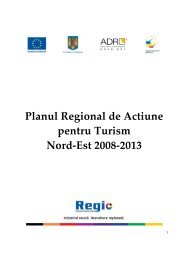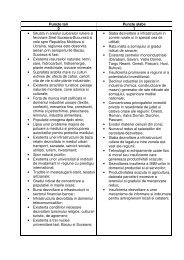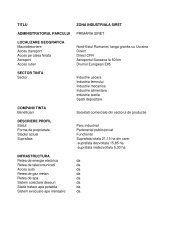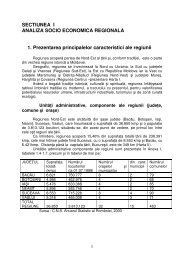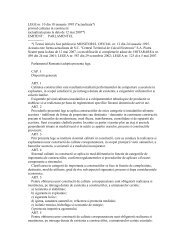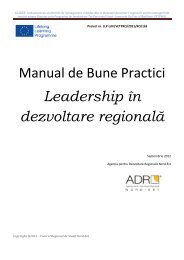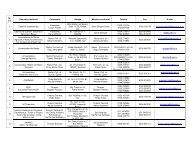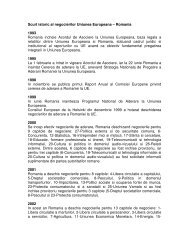Global North-East SWOT Analysis Strong Points Weak Points ...
Global North-East SWOT Analysis Strong Points Weak Points ...
Global North-East SWOT Analysis Strong Points Weak Points ...
Create successful ePaper yourself
Turn your PDF publications into a flip-book with our unique Google optimized e-Paper software.
<strong>Global</strong> <strong>North</strong>-<strong>East</strong> <strong>SWOT</strong> <strong>Analysis</strong><strong>Strong</strong> <strong>Points</strong><strong>Weak</strong> <strong>Points</strong>• Increase with 8.3% of the real regionalGDP in 2001, higher than the nationallevel (5.73%);• Increase with 16.4% of the real regionalgross added value in industry (7.1%national level) - 2001;• Presence of European road E85 crossingthe region <strong>North</strong> to South and of thethree airports of the region: Bacau, Iasiand Suceava;• High input of SMEs to the hotels andrestaurants business turnover 62.40% –year 2002, as the balance was done bysmall enterprises;• Positive natural population growth (singlein Romania) – 0.6% per 1.000inhabitants – in 2002;• Building up within PHARE 2000 of theTechnological Park, Iasi and the IT Parkin Hemeiusi-Bacau;• Building up the bridge Radauti Prut –Lipcani within PHARE 2002 and this wayincrease the transport rate to Republic ofMoldova;• Development of the leisure resort inPiatra Neamt through PHARE 2000;• Presence of three universities includingin their core activity also: R&D, design,technological innovation, IT andpromotion of information society;• Presence of cultural centers,monasteries, national and international(UNESCO heritage) historicalmonuments;• Well developed bank network at regionallevel.• The regional GDP/capita is 71.7% out ofthe national (the lowest rate);• Highest poverty rate of all the regions40.7% in 2001.• Labor output is lower in all fieldscomparing to national level (vezichap.2.1 of economic-social analysis)1998-2001;• The lowest number of SMEs to 1.000population comparing to other regionsduring 2000-2002;• Agriculture input to regional GDP(20.96%) is higher than national level(14.97%) 2001, showing the dependencyof regional economy to agriculture;• Low rate of modernized roadinfrastructure – 58% of the roadinfrastructure is below the minimumaccepted standard - 2002;• No international flights on the threeairports because of the poor equipmentand facilities;• 343 communes and villages only out of2.908 connected to potable water supplysystems;• Low growth of the potable water networkwhen compared to the region surfaceand population in 2002:• km of network/100sqkm: 12.55comparing to 16.89 national;• km of potablenetwork/1.000population: 1.23comparing to 1.84 national;• Low growth of sewerage networkcompared to the region surface andpopulation in 2002:• Out of 375 locations connected topotable water network only 131are connected to the sewerage;• Low growth of the natural gas networkwhen compared to the region surfaceand population in 2002:• km natural gas netw./1.000pop.:0,59 compared to 1,10 national;• km natural gas netw./100sqkm:5.47 comparing to 10.09 national;• Insufficient waste water treatmentcapacity (70% out of required) and wastedump (60% out of required);• Low rate of using the accommodationcapacity in use (28.90%) compare toRDA NE <strong>SWOT</strong> <strong>Analysis</strong> RDP 2007-2013 PAGE 1
Opportunities• Location of the region as the easternborder of EU in the futures;• Forecasted decrease of inflation rate anddecrease of the credit cost consequently;• Presence of Action Programs at nationallevel for: environment, HR, anti-poverty,industry, spatial planning, SMEs;• Encouraging new types of tourism andvalorization of historical, cultural, spiritualand traditional heritage;• Presence of raw materials: constructionmaterials and wood (see naturalresources) attractive for foreigninvestors;• Setting up SIRET-PRUT-NISTRU Euroregion;• Setting up the Economic CenterSuceava, Business Incubator Botosaniwithin PHARE 2001;• Funding of ‘Rehabilitation of AgapiaMonastery Tourist Area’ and ‘BusinessCenter Tutova-Barlad’ within PHARE2002;• Support to business by modernizing theregion’s airports as tourists startingpoints for region tourists routes;• Running the ‘Stefan cel Mare – 500years memorial’ project funded byRomanian government;other regions and national (34.00%) –year 2002;• Average stay over night in the region (2.7nights per tourist), lower than national(3.59 nights per tourist) – year 2000;• High rate of population employed inagriculture - 51,12% and a low one inservices 28,88% – 2002;• High percentage of populationconcentrated in rural area: 59.23% out ofthe total population of the region;• High unemployment rate of the region10.6% compared to the national one –8.8%, and Neamt county as 14.1% - in2001;Risks• Lack of cohesion if the economic andsocial provisions on the background ofincreased population mistrust into thecountry economic coming back tonormal;• Continuation of ‘brain drain’ to otherregions and countries;• Continuous increase of the populationpoverty rate in the region;• Presence of areas with a high risk ofnatural disasters (earth slides, floods,etc.);RDA NE <strong>SWOT</strong> <strong>Analysis</strong> RDP 2007-2013 PAGE 2
INFRASTRUCTURE<strong>Strong</strong> points<strong>Weak</strong> points• Presence of European road E85 crossing • Lack of an European road corridor east-<strong>North</strong>-<strong>East</strong> Region from <strong>North</strong> to South; West;• Presence of 3 regional airports (Iasi andBacau as international) and the railnetwork providing connections to otherregions;• Low density of modernized roadinfrastructure – 58% out of the region’sinfrastructure is lower than minimumstandards –2002;• Railway density per 1.000 sqkm (40.9)higher than national level –2002;• Lack of international flights on thecurrent three airports due to poor• Building up within PHARE 2000 of the provided equipment;Technological Park, Iasi and the IT Parkin Hemeiusi-Bacau;• 343 communes only out of a total of2.908 connected to the potable water• Setting up the Economic Centernetwork;Suceava, Business Incubator Botosaniand the Business Center Tutova-Barlad’• 22 town only out of a total of 32connected to natural gas network;within PHARE 2002;• High number of locations with no natural• Presence of the modernized roadRoman-Iasi and the road corridorsSuceava <strong>North</strong>-<strong>East</strong> (E 577-576).gas, water supply and seweragenetwork, not connected to gas 87,69%,to sewerage 95.58% and potable watersupply 87.25% out of the total region’slocations total;• Low development rate of the potablewater supply network compared tosurface and population in 2002:• km network/100 sqkm: 12.55compared to 16.89 national;• km potable network/1.000pop.:1.23 compared to 1.84 national;• Low rate of sewerage networkdevelopment compared to region’s sqkmand population 2002:• Out of 375 locations connected topotable water network only 131are connected to sewerage;• Low rate of natural gas networkdevelopment compared to region’s sqkmand population 2000:• 0,59 compared to 1,10 national;• km natural gas network/100sqkm:5.47 compared to 10.09 national;• Low rate of education infrastructuredevelopment and modernizing both ruraland urban;• Lack of modern facilities in healthinfrastructure;• Low access to mountain tourist locationsand forest exploitations.RDA NE <strong>SWOT</strong> <strong>Analysis</strong> RDP 2007-2013 PAGE 3
INFRASTRUCTUREOpportunitiesRisks• Higher number of passengers to use theregional air infrastructure (studyproduced by German Airport Consulting• Low cooperation between local andcounty public administrations to promotelarge regional projects;Group);• Low capacity of region’s population to• High demand to modernize and extendtransportation infrastructure, particularlythe road one;takeover specific costs for maintenanceof rehabilitated or new infrastructure dueto current poverty rate;• Setting up the regional infrastructurepartnership group;• Law background still keeping statemonopoly for providing certain types of• Possibility to get fundings through theRomanian Social Development Fund;services for utilities infrastructure.• Setting up of the SIRET-PRUT-NISTRUEuro-region;• Funding of ‘Rehabilitation of SiretIndustrial Area’ within Phare 2000.• Running the ‘Stefan cel Mare – 500years memorial’ project funded byRomanian government.ENVIRONMENT<strong>Strong</strong> points<strong>Weak</strong> points• Higher quantity and quality potable waterresources in Neamt, Suceava comparedto other areas;• Constant atmospheric pollution mainly inbig towns and around industrial areaswith frequent exceeding of maximum• Reduction of pollution from big industrial environment specific indicators;polluters and step by step replacing ofthose with SMEs (providing flexibility andadaptability to environment requirements)• Pollution of ground and undergroundwater due to uncontrolled spills ofcompanies, accidents and poor• Low scale using of pesticides anddevelopment of sewerage in rural area;fertilizers;• Low capacity of waste water treatment• Providing high tech for environmentquality monitoring (Suceava, Neamt,(70% out of required) and wastes dumpplatforms (60% out of required);Bacau);• Lack of centralized water supply in rural• Implementing Local Agenda 21 in Iasi. and some urban outskirt areas;• Low percentage of high quality groundwater (22% first quality on river Prut and57% on river Siret);• High soil erosion in most of the region’sjudets, particularly Vaslui (71% out of thejudet total farming area);• Non-selective collection of wastes in ruralareas;• Uncontrolled storing of wastes in ruralareas;• Uncontrolled deforestation causing earthslides;• Lack of potable water resources in judetsIasi, Vaslui, Bacau and Botosani.RDA NE <strong>SWOT</strong> <strong>Analysis</strong> RDP 2007-2013 PAGE 4
Opportunities• Presence of programs ith internationalco-finance directed to environmentprotection (LIFE, ECOLINKS, REC);• Increase of local authorities interest topromote partnerships for environmentprotection;• Presence of cooperation with Dutch andNetherland ministries for environmentprotection;• Setting up the National EnvironmentProtection Fund to support priorities ofNational Plan for Environment Protection.• Approval of National Plan for WasteManagement;• Presence of Local Action Plans forEnironment Protection.Risks• Low output rate of areas in the proximityof industrial areas;• High risk of eutrophication of the lakes;• Presence of high risk natural disasterareas (earth slides, floods);• Low funds for environment protection;• Continuous uncontrolled deforestationwith effects on air pollution and soilerosion.BUSINESS<strong>Strong</strong> points<strong>Weak</strong> points• High percentage of employees active inSMEs and micro-enterprises, 55.10% outof the total employed – year 2002;• Lowest number of SMEs per1.000pop.compared to the other regionswithin 2000 – 2002;• High input of SMEs into regional hotel andrestaurants - 62.40% – year 2002;• Low rate of SMEs output in processingindustry as 30.09%;• High and even distribution of microenterprisesover all activity sectors exceptelectricity;• Low cooperation betweenuniversities/R&D and SMEs to providetechnologic transfer and innovation• 100% of gross investments of SMEs in development;hotels and real estate – year 2002; • Low participation of micro-enterprises• Hotel and restaurants turnover is 100% and SMEs to export;done by micro-enterprises and SMEs – • Immature consultancy services sector.year 2002.OpportunitiesRisks• Setting up industrial parks within PHARE2000: Industrial technological Park, Iasi• Unstable politics and frequent lawalterations (including fiscal ones);and IT Park, Hemeiusi, Bacau and alsobuilding Radauti Prut-Lipcani bridge,Romania-Republic of Moldova - which is• Low rate of infrastructure developmentboth rural and urban as quantity andquality;to stimulate regional business;• Lack of cash, financial obstruction;• Setting up the Bucovina-SuceavaEconomic Center, the Botosani Business• Low association level of SMEs in theregion;Incubator, and Busness Center Tutova-Barlad within PHARE 2001;• Low management training.• Presence of National Multi-annualProgram for Technological and BusinessIncubators by National office for SMEs;• Forecasted decrease of inflation rate andconsequent credit cost reduction;• Presence of raw materials: constructionand wood (see natural resources) whichare to attract foreign investors;RDA NE <strong>SWOT</strong> <strong>Analysis</strong> RDP 2007-2013 PAGE 5
• The three regional airports could becomeby appropriate modernizing the connectionin between NE region and potentialinvestors.TOURISM DEVELOPMENT<strong>Strong</strong> points<strong>Weak</strong> points• Presence of cultural, religious andnational and international importantmonuments (UNESCO);• Low rate of operational accommodation(28.90%) compared to other regionsand national (34.00%) – year 2002;• Presence of appropriate circumstances todevelop religious, wildlife and historicaltourism;• Lowest rate of stay over night of all ofthe regions (2.7 nights per tourist),lower than national(3.59 nights per• Presence of health resorts;tourist) year 2000;• Development of the leisure resort inPiatra Neamt through PHARE 2000;• Poor regional infrastructure (as perchap.2);• Lack of a regional private tourism body.Opportunities• Improvement of utilities and physicalinfrastructure;• Rehabilitation of tourism on Agapiamonastery within PHARE 2002;• High support for community tourismprograms;• Encouraging new tourism (religious,wildlife);• Setting up tourism workgroup Siret-Prut-Nistru Euro-region.Risks• Gaps in between Romanian and foreigntourist services fees;• Tourist migration to other countriesand/or regions.SUPPORT TO R&D, INNOVATION and IT, CREATION of IT SOCIETY<strong>Strong</strong> points<strong>Weak</strong> points• Presence of three university centers withcore business as: R&D, invention,technological innovation, IT and IT societypromotion;• Presence in <strong>North</strong>-<strong>East</strong> region of 73 unitsactive in R&D, technological development(about 12% out of the national total);• Presence in the region of 607 innovationenterprises (15.3% out of the national);• Presence in the region of software and ITservices providers.• RDA NE participation into community cofinanceSAIL and PARTNER programs ininnovative development and academicregion development but also cooperationwith industrial sector to facilitateinformation exchange;• Low funding rate of research-innovationsector (60% of the resources areRomanian government);• Regional R&D costs are 5% out of thenational level during 1998-2002;• Enterprises R&D costs are only 0.07%out of the regional turnover – 2002;• Low cooperation in between academic,research and business sectors on usingthe research outputs and technologictransfer to the economy.RDA NE <strong>SWOT</strong> <strong>Analysis</strong> RDP 2007-2013 PAGE 6
Opportunities• Setting up industrial parks within PHARE2000: Industrial technological Park, Iasiand IT Park, Hemeiusi, Bacau;• Presence of the National ProgramINFRATECH to support and developspecialized companies in innovationinfrastructure and technologic transfer;• Faster development of electroniccommerce and generally e-businessmarket;• Financial support to SMEs on e-commerceprojects, support to e-commerceapplications developers (as the oneprovided by UK within the Stability Act forSouth-<strong>East</strong> Europe);• Free telecommunication market startingJa.01, 2003;• Development of IT society bycommunication channels convergence, e.g.integration into a single channel of voiceservices, interactive TV, videoconferencesand data transmission;• Presence on the market of European andUS IT providers promoting the mostadvanced technologies.Risks• Inappropriate and/or unstable lawbackground concerningtelecommunications and informationtechnology;• Migration of qualified and specializedlabor in research-innovation to otherregions but mainly to other countriesoffering higher motivating salaries;• High rate of IT piracy (about 70%)endangering the development of thissector;• High cost of access to technology thatcould generate new gaps between<strong>North</strong>-<strong>East</strong> region and other countries;• Lack of basic elements for ITdevelopment such as freedom ofinformation, data protection, applicationof copyright law;• Low availability of enterprises forresearch-innovation and technologictransfer outputs mainly due to financialresources.RURAL DEVELOPMENT AND MODERNIZATION OF AGRICULTURE<strong>Strong</strong> points<strong>Weak</strong> points• Highest input to national farming value –19.52% in 2002;• Input of forestry, wood processingwildlife preserve, fishing and fishfarming to regional gros added value of1.26% higher than the national one –0.55% - year 2001;• <strong>North</strong>-<strong>East</strong> region is provided with14.36% out of national farming area and18.49% forests –2002;• The highest provider of wood forprocessing 32.83% out of the nationaltotal – 2002;• High tourist, cultural, historic andlandscape potential in rural areas;• Presence of collecting and processingcenters of farming products in VatraDornei, Bacau, Piatra Neamt;• Presence of very good centers fororchards (judets Iasi and Suceava) andvineyards (judets Iasi, Vaslui and• Agriculture input to regional GDP (18.70)higher than the national (13.37%) and tothe gross regional added value 20.96%compared to national of 14.97% - 2001 –showing the regional economydependency on agriculture;• High population percentage concentratedin rural area: 59.23% out of the regionpopulation;• Out of total active population 51.12% isoccupied in agriculture – 2002;• Lack of a redistribution of activepopulation from agriculture to servicesand industry sectors;• Farming is performed on small lots ofabout 1-3 ha;• Low rate of association (8% for lands and3% cattle stock);• High erosion of (out of 325.000ha ,200.000ha are eroded);RDA NE <strong>SWOT</strong> <strong>Analysis</strong> RDP 2007-2013 PAGE 7
Bacau);• Presence of Genes bank in judetSuceava (unique in Romania);• Presence of lakes, as judet Botosani isthe first one in Romania.Opportunities• Running in judet Suceava of the largestinfrastructure project with foreignfunding (‘Suceava – European StandardUtilities and Environment’), which is tobring rural utilities infrastructure toEuropean standards;• Fundings of Romanian SocialDevelopment Fund in ruralinfrastructure, income generation andsocial services;• Running in judet Botosani a pilot projectfor rural development funded by WorldBank;• Presence of National Plan forAgriculture and Rural Development;• Granting facilities for associationpurposes to farming land owners;• Increasing of agriculture yield due to theuse of organic fertilizers for a long time;• Approval of National FrameworkProgram for Restructuring andModernizing of Cattle stock units andfood sector;• Valorizing the present fish farmingpotential.• Only 343 communes and villages out of atotal of 2.908 are connected to potablewater systems (11.79%);• Only 98 communes and villages out of2.908 are connected to public seweragesystems (3.37%);• Only 40 communes and villages out of2.908 are connected to natural gasnetwork (1.37%);• High infant mortality rate in rural areahigher than the urban one;• Low and obsolete farming equipmentpark.Risks• Possibility that some farming products(meat, milk, vegetables) to mismatch theEU quality standards (requirement toregister the traditional products to theState Register for Inventions and Brands -OSIM);• Low access to agriculture type credits.HUMAN RESOURCES AND SOCIAL SERVICESRDA NE <strong>SWOT</strong> <strong>Analysis</strong> RDP 2007-2013 PAGE 8
<strong>Strong</strong> points• High young population percentage -32.87% in 2002;• Positive natural population growth (singlein Romania) – 0.6% per 1.000inhabitants – in 2002;;• Presence in the region of 18,75% out ofthe total number of schools and 19,48%total number of student in Romania(school year 2002-2003);• Highest number of art and vocationalschools (32.94% out of the nationaltotal), including 20.22% of the nationalstudent population – school year 2002-2003;• Presence of university centers Iasi,Bacau and Suceava where there isresearch (a quarter of the national total)including 75.399 students as 12.64% outof the national level – school year 2002-2003;• Social assistance cafeterias are 18% inthe region out of the national total.Capacity provided by these units is20.66% out of the national total (2002);• Presence of the Counseling Center forWomen and Children suffering fromDomestic Violence.<strong>Weak</strong> points• High population percentage concentratedin rural area: 59.23% out of total regionalpopulation (2002);• Highest poverty rate out of all regions +40,7% (2001);• High rate of population occupied inagriculture - 51,12% and low in servicesector 28,88% – year 2002;• High unemployment rate in the region10.6% compared to the national rate –8.8% and judet Neamt reaching 14.1% -year 2001;• Unemployment BIM young people rate(age 15-24) is 2.25 times higher that totalBIM unemployment – year 2002;• Young population (age 15-34) is thehighest unemployed BIM out of totalpopulation – 14,8% in 2002;• Lack of a redistribution of activepopulation from agriculture to servicesand industry sectors;;• Lack of appropriate training units mainlyfor vocational and apprenticeship, lack ofequipment keeping the pace with thepermanent changing requirements onlabor market;• Highest infant mortality rate of all theregions: 20.6 deaths to 1.000 living births- 2002;• Low number of counseling centers forwomen and children suffering fromdomestic violence;• Low number of counseling integratedservice centers for self-sustainedpersons.Opportunities• Design of the Regional Action Plan forEducation (PRAI) 2004-2010;• Presence of the regional ContinuousFormation Center for PublicAdministration in Iasi;• Setting up the <strong>North</strong>-<strong>East</strong> Consortium forProfessional and Technical EducationDevelopment -TVET;• Presence of the National Plan for LaborOccupation;• Presence of National and Judets Antipovertyand Social Inclusion Plans;• Decrease of income tax rate;Risks• Migration of qualified labor to otherregions and countries;• Poor capacity of consultancy companiesin the region with negative effects onattracting and spending EU, WB andother international donors funds;• Increase of the crime rate due to lack ofeducation.RDA NE <strong>SWOT</strong> <strong>Analysis</strong> RDP 2007-2013 PAGE 9



